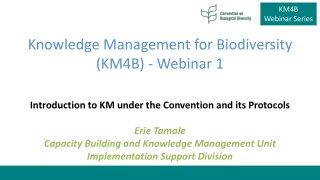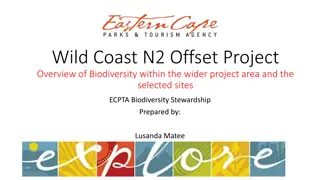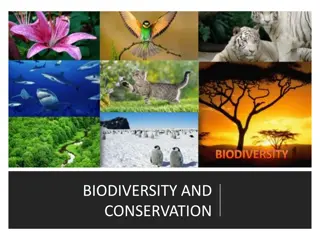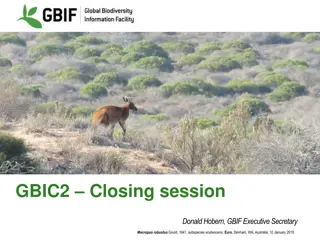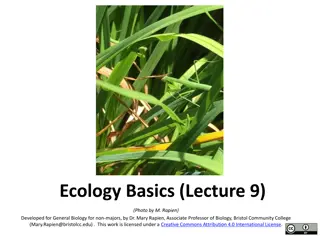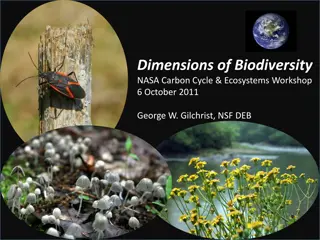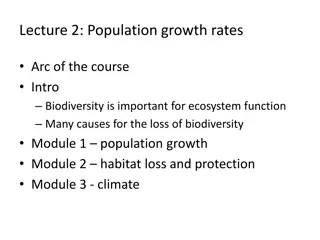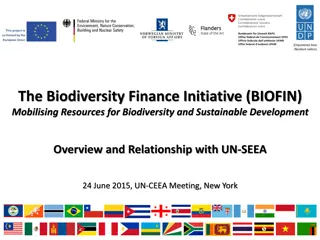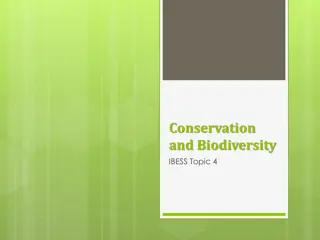Exploring Hakaluki Haor: A Lesson on Biodiversity and Economic Importance
Dive into the breathtaking world of Hakaluki Haor with this educational presentation. Learn about the unique biodiversity, economic significance, and ecological importance of this wetland in Bangladesh. Discover the different kinds of fishes and birds that call Hakaluki Haor their home, and expand your vocabulary with new terms related to this fascinating ecosystem. Immerse yourself in the beauty and knowledge of this natural wonder through vivid images and informative content.
Download Presentation

Please find below an Image/Link to download the presentation.
The content on the website is provided AS IS for your information and personal use only. It may not be sold, licensed, or shared on other websites without obtaining consent from the author. Download presentation by click this link. If you encounter any issues during the download, it is possible that the publisher has removed the file from their server.
E N D
Presentation Transcript
Teachers Identity MAFUZA AKTER Lecturer of English Kushtia City College, Kushtia Class-XI Time-45 minutes
Learning Outcome After Reading The Text Students Will Know About- the location and surrounding areas of Hakaluki Haor Kinds of fishes and birds available in Hakaluki Haor the economic importance of the Haor the ecological importance of the Haor some new vocabulary
Todays Learning Topic The Hakaluki Haor Unit 8 Lesson 2
The Location of The Hakaluki Haor Hakaluki Haor is bounded by the Kushiara river as well as a part of the Sonai-Bardal river to the north, by the Fenchuganj-Kulaura railway to the west and to the south, and by the Kulaura-Beanibazar road to the east. The haor falls under two administrative districts, Maulvibazar and Sylhet.
Hakaluki haor is one of the major wetlands of Bangladesh. With a land area of 18,386 hectares, it supports a rich biodiversity and provides direct and indirect livelihood benefits to nearly 190,000 people.
Hakaluki Haor is an important source of fisheries resources for Bangladesh . Kalibaus, Boal, Rui, Ghagot, Pabda and Chapila are the main fish species found here.
Fishermen are catching fish in The Hakaluki Haor
The Haor is a very important resting place for migratory waterfowls
The haor system provides a wide range of economic and non- economic benefits to the local people as well as to the people of Bangladesh. These include fish production, rice production, cattle and buffalo rearing, duck rearing, collection of reeds and grasses, and collection of aquatic and other plants.
Economic importance of the Haor
The water of The Hakaluki Haor is being polluted in many ways
The water of The Hakaluki Haor is being polluted in many ways
Death of Birds and fishes of The Hakaluki Haor for pollution
TEXT Bangladesh is blessed with huge inland open water resources. It has numerous river canals, beels, lakes, and vast areas of floodplains. Hakaluki haor is one of the major wetlands of Bangladesh. With a land area of 18,386 hectares, it supports a rich biodiversity and provides direct and indirect livelihood benefits to nearly 190,000 people. This haor was declared an Ecologically Critical Area in April 1999 by the government of Bangladesh. Hakaluki is a complex ecosystem, containing more than 238 interconnecting beels and jalmahals. The most important beels are Chatla, Pinlarkona, Dulla, Sakua, Barajalla, Balijhuri, Lamba, Tekonia, Haorkhal, Tural, Baghalkuri and Chinaura. Hakaluki Haor is bounded by the Kushiara river as well as a part of the Sonai- Bardal river to the north, by the Fenchuganj-Kulaura railway to the west and to the south, and by the Kulaura-Beanibazar road to the east. The haor falls under two administrative districts, Maulvibazar and Sylhet. Some 190,000 people live in the area surrounding the haor. Hakaluki Haor is an important source of fisheries resources for Bangladesh. Kalibaus, Boal, Rui, Ghagot, Pabda and Chapila are the main fish species found here. From the Kushiara there are frequent upstream movement of fish towards the beels and tributaries of Hakaluki. The beels in Hakaluki haor provide winter shelter for the mother fisheries.
TEXT In early monsoon these mother fisheries produce millions of fries for the entire downstream fishing communities. Floodplains are also an important source of fisheries resources within the area. However, many of the beels have lost their capacity to provide shelter for mother fisheries because of sand deposits from upstream rivers and canals, use of complete dewatering technique for fishing and lack of aquatic plants to provide feed and shelter for parent fish. The haor is a very important resting place for migratory waterfowls flying in from the north. The most interesting species is the Barheaded Goose, which is now hardly seen in fresh water wetlands. Many other important species of waterfowls make the Haor their temporary home. Unfortunately, illegal poaching has been a threat to the waterfowl population in this vast wetland. Hakaluki haor is known as a good grazing land in winter. People from villages around the Haor and also from distant areas send their herds for grazing. During this time, herders make temporary shelters near the beels and graze their animals for a period of 4- 5 months. The Haor had very dense swamp forests in the past, but deforestation and a lack of conservation practices have virtually destroyed this unique forest in the last two decades.
TEXT Two small patches of swamp forests still exist in the area of which one is in Chatla beel and the other near the village of Kalikrishnapur. With the exception of these two swamp forest patches, the vegetation surrounding Hakaluki haor is unique. It includes both swamp forest as well as mixed evergreen rain forest. Thatching material is the most useful natural wetland product of the area. The haor system provides a wide range of economic and non-economic benefits to the local people as well as to the people of Bangladesh. These include fish production, rice production, cattle and buffalo rearing, duck rearing, collection of reeds and grasses, and collection of aquatic and other plants. The haor system also protects the lower floodplains from flash floods occurring in the months of April-May, maintains the supply of fish in other lower water bodies and provides habitat for migratory and local waterfowls. The unique haor system contributes to the beauty of the landscape both during the monsoon and the dry season. In monsoon, its unique scenic beauty makes it a huge natural bowl of water and in the dry season it becomes a vast green grassland with pockets of beels serving as resting places for migratory birds. This unique natural system can be a major attraction for tourists.
1 (A). Multiple Choice Questions # Choose the correct answer: (i) Bangladesh is blessed with refers to- (a) Bangladesh is a blessing (b) Bangladesh is lucky to have (c) Bangladesh is beset with (d) Bangladesh is a beauty (ii) The best synonym of the word tributaries is- (a) Tribute (b) Branches (c) Water (d) Flood (iii) What is the contextual meaning of livelihood ? (a) way of life (b) stage after adulthood (c) source of life (d) source of income (iv) The word numerous stands for- (a) namely (b) numberless (c) many (d) numbered (v) What does Hakaluki Haor provide to 1,90,000 people? (a) a good communication benefit (b) livelihood benefit (c) irrigation facility (d) safe water
Multiple Choice (vi) The word bounded refers to- (a) fixed (b) ignored (c) encircled (d) emancipated (vii) What do you mean by resources ? (a) rivers (b) massed (c) fries (d) assets (viii) What does the word ecosystem mean- (a) complex web (b) ecological community (c) atmosphere (d) ecological balance (ix) Technique means- (a) cultivation (b) skill (c) siltation (d) method (x) The word Area refers to- (a) habitation (b) locality (c) region (d) settlement
2. Complete the table with relevant information from the text Who/What Activities Reason/ Why Where/When Bangladesh (i) ----------------------- For its huge island open water resources (ii) because of ---------- Hakaluki Haor One of the major wetlands (iii) --------------------- Hakaluki Haor (iv) --------------------- 1999 Hakaluki Haor Considered a complex ecosystem (vi) --------------------- (v) ----------------------- Hakaluki Haor For its fisheries resources (vii) ------------------- (viii) ----------------- Take winter shelter Hakaluki Haor (ix) ------------------ Bring about million of fries Lost the capacity to provide shelter Early monsoon Many of the beels (x) ----------------------- From upstream rivers and acnals
2 (Or). Flow Chart Make a flow chart showing the blessings of Hakaluki Haor: 1. Supporting rich biodiversity 2 3 4 5 6
Group Work 1. Why is Hakaluki Haor economically important? 2. When and why do migratory birds come to Hakaluki Haor?
PAIR WORK 1 (B). Short Questions #Answer the following questions: (a) Why is Hakaluki Haor an important source of fisheries? (b) What is the surrounding area of Hakaluki Haor? (c) Why is Hakaluki Haor called a complex ecosystem? (d) What are mother fisheries? What do they do? (e) Why have many of the beels lost their capacity to provide shelter for mother fisheries?
Evaluation 1. Why is Hakaluki Haor an important source of fisheries? 2. Describe the natural beauty of Hakaluki Haor.
Home Work Imagine, you work in a tourist agency. You are going to make a leaflet on The Hakaluki Haor to attract tourists. Make a draft of 100 words for the leaflet highlighting all the attractions of The Hakaluki Haor
Thank You All BYE










